Japan Wood Products
Prices
Dollar Exchange Rates of
11th April 2014
Japan Yen 101.63
Reports From Japan
Companies remain concerned over prospects for
continued growth
The latest survey of sentiment amongst Japanese
companies is showing that all firms are increasingly
pessimistic about prospects the rest of the year.
This highlights private sector concerns on the impact of
the consumption tax rise on consumer spending in the
coming quarter which is expected to drop sharply after the
booming sales prior to 1 April when consumers had rushed
to buy everything from cars to groceries ahead of the tax
rise.
Business sentiment in Japan in the first quarter of this year
was almost stagnant. Today‟s corporate sentiment is
weaker than when Japan last raised the tax in 1997.
The sentiment index for big manufacturers rose in the first
quarter by just one point from three months ago to plus 17,
the fifth quarter of improvement but below expectations.
The future outlook, as assessed by big manufacturers, fell
9 points.
For the Cabinet Office survey see:
www.boj.or.jp/en/statistics/tk/index.htm/
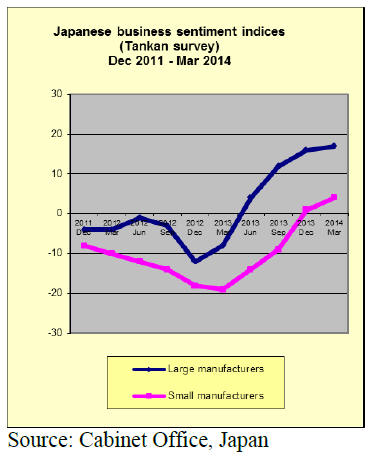
While analysts say this time Japan's economy should have
a better chance of adjusting to the current tax rise than
when it was last raised retailers are forecasting a sharp
drop in sales in the second quarter.
No immediate response by BOJ to weak economic
news
The Bank of Japan (BoJ) surprised the financial markets
by keeping its policy unchanged. Most analysts had
expected the Bank to announce additional stimulus
measures but the Bank has not reacted immediately, the
latest weak economic data may prompt them to act soon.
For the full press release see:
https://www.boj.or.jp/en/announcements/release_2014/k14
0408a.pdf
The latest statement from the BoJ says Japan's economy
continues to slowly recover despite a negative impact from
the consumption tax increase. The Bank notes that
advanced economies are showing signs of recovery which
is good news for Japanese exporters.
Japan‟s exports have recently levelled but there has been
an improvement in business investment as corporate
profits have improved. Private consumption and housing
investment were resilient and there have been
improvements in employment opportunities and incomes.
The Bank insists business sentiment continues to improve
but that the recent weakening of sentiment presents a
challenge for the short term. Inflation expectations (but not
the reality) appear to be rising says the Bank and the
outlook is that the Japanese economy will gradually
strengthen once the impact of the tax increase on
consumer spending fades.
The Bank says it will continue with quantitative and
qualitative monetary easing as long as necessary to
achieve its 2% inflation target.
February machinery orders down 6% year on year
Business sentiment as gauged by the level of machinery
orders has weakened. Machinery orders are published
regularly and have been found to be good indicators of
sentiment as they reflect capital spending for future
production.
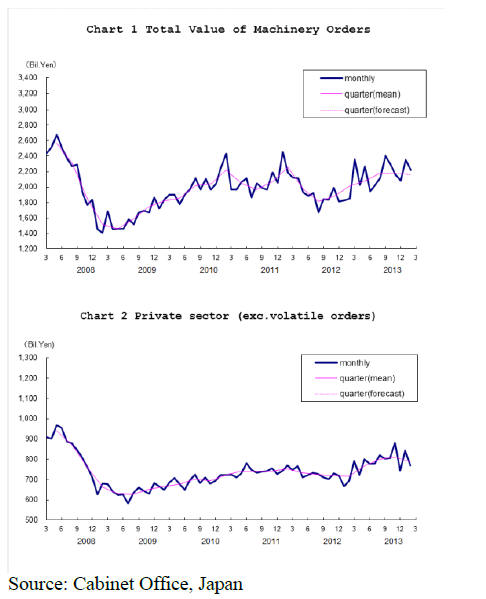
In February the value of orders for machinery received by
Japanese manufacturers fell by almost 6% from a month
earlier suggesting manufacturers are pessimistic on the
midterm economic prospects.
Orders placed by the private-sector declined 8.8%
excluding orders for ships and orders from power
companies. The drop in orders in February comes after the
healthy January increase of 13% which was the best
performance since early 2013.
In a recent assessment the Japanese Cabinet Office has
changed its assessment of machinery order trends saying
the orders have stalled and that the outlook is challenging.
For more see:
http://www.esri.cao.go.jp/en/stat/juchu/1402juchu-e.html
The sharp reaction of consumers and businesses to the
consumption tax increase on 1 April is not surprising but
most analysts do not see a turn-around in growth until the
third quarter.
Too early to assess impact of tax hike
From 1 April the consumption (sales) tax was raised by
3% to 8%. The government has indicated that if the
economy remained on a growth track it will increase the
tax to 10% in October 2015.
The fast pace of consumption tax rises are necessary to
finance soaring social welfare related to Japan's rapidly
ageing population.
Recent assessments of the population age distribution
show that by 2025 people over 65 could account for
around 35% of the population. As the birth rate in Japan
continues to fall there are serious concerns about Japan‟s
future economic growth.
The need to raise the consumption tax has been discussed
in Japan for several years and previous attempts by various
administrations to raise the tax have been disastrous and
the current rise will be a challenge to the government‟s
efforts to lift the country out of its deflationary spiral.
Yen strengthens against US dollar
The US dollar fell more than 1 percent against the yen in
early April on the back of the 8 April policy statement
from the Bank of Japan (BoJ) which ruled out the
immediate need for additional stimulus.
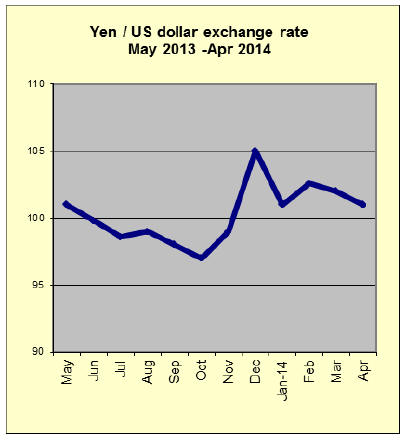
In a news conference held after the latest Policy Board
meeting the BoJ Governor said, while the economy is sure
to slump in the second quarter because consumer spending
will decline sharply, a return to solid growth can be
expected from the third quarter of this year.
The BoJ decision not to inject more liquidity into the
market was read as supporting the yen but any significant
strengthening of the yen is expected to bring a swift
response.
Trade news from the Japan Lumber Reports (JLR)
The Japan Lumber Reports (JLR), a subscription trade
journal published every two weeks in English, is
generously allowing the ITTO Tropical Timber Market
Report to extract and reproduce news on the Japanese
market.
For the JLR report please see:
http://www.nmokuzai.
com/modules/general/index.php?id=7
Bewilderment on Wood Use Point system
For the Wood Use Point system, American Douglas fir
and European whitewood have been selected as qualified
species for the system. American Douglas fir has been
supported by majority of prefectures.
However, in Kyushu, there are mounting voice of
bewilderment and resentment by prefectural councils and
domestic timberland owners. The reason is that the
system‟s one of the conditions is spill-over effect of use of
particular species for local economy and employment.
The Forestry Agency‟s guideline for the system states the
main objective of the system is to stimulate local business.
Four prefectures of Kagoshima, Miyazaki, Kumamoto and
Ohita in Kyushu, where is the main supply region of
domestic logs, are still discussing whether Douglas fir is
appropriate for qualified species and have not made
recommendation like other prefectures.
Douglas fir has been widely used for beam and girder and
many areas enjoy ripple effect of Douglas fir demand such
as employment by sawmills, processing and distribution.
Lumber dealers are anxious to handle Douglas fir lumber
as it is popular items for wooden units but in domestic
timber growing regions, there is very little benefit of
Douglas fir or rather it gives negative impact.
If Douglas fir is approved for beam and girder for the
Wood Use Point system, builders do not have to use
domestic wood. This is reverse move to the measures the
government has been taking.
There are many measures to encourage using domestic
wood so that builders have been trying to use domestic
wood products for post, beam, sill and stud and plywood
made of domestic species. They wonder why imported
species are qualified so fast without considering local
conditions.
Big increase in Japan’s log exports
Export of domestic logs in 2013 was 264,000 cbms,
133.0% more than 2012. This is the highest export since
the Japan Wood Products Export Promotion Council
started gathering statistics. In particular, the export to
China soared to 129,000cbms, 797.2% more.
The Ministry of Agriculture, Forestry and Fisheries made
up export promotion strategy of agricultural and marine
products and target of forest products export value of 25
billion yen by 2020 from 12.3 billion yen in 2012.
In 2013, because of robust demand in China and help of
weak yen, log export to China expanded to 129,000cbms
from 14,000 cbms in 2012.
Log export also increased for Taiwan P.o.C andS. Korea
so total log export more than doubled in 2013. Lumber
export was only 66,000 cbms, 2.9% more but growth is
low.
In 2014, China‟s wood structure standard is revised, which
allows use of Japanese cedar, cypress and larch for
structural materials so further increase of demand for
Japanese logs is expected.
Price hike by secondary processors of South Sea
plywood
Secondary plywood processors to make print plywood and
color plywood are facing higher cost of raw materials so
they are proposing higher prices since April.
Because of price increase of imported South Sea
hardwood plywood mainly due to weaker yen, the
manufacturers increased the sales prices about a year ago
but it was hard to pass higher cost onto sales prices.
Currently the prices of imported thin plywood have been
climbing due to higher log cost, labor cost and energy cost
in producing regions plus weaker yen in Japan. The
manufacturers have to use such high cost materials when
the demand is slowing by consumption tax increase since
April.
There is no other way to absorb higher cost but to price
hike. Meantime, house builders have no room to accept
higher materials cost when new orders are declining. So
the situation is very severe for the manufacturers.
Plywood
Shipment of domestic softwood plywood has been brisk
for large builders and precutting plants. Despite forecast
of slower movement in March, surplus supply went to
large builders.
February production was 215,200 cbms, 9.1% more than
the same month a year ago and 1.2% down from January.
The shipment in February was 220,900 cbms, 7.8% more
and 8.2% more. Therefore, the inventories have kept
declining for five straight months. With low inventories, it
becomes hard to have variety of items other than common
12 and 24 mm panels.
Since late 2013, the movement of imported plywood got
active by bullish FOB prices and weakening yen and the
market prices shot up with some speculative demand then
by late February the fever simmered down in Tokyo
region.
The importers succeeded to make profit by this price
increase then keep carrying low cost inventories as future
arrivals would cost higher so usual dumping sales in
March end book closing period did not take place. Supply
side continues bullish as there is talk about log harvest tax
increase in Indonesia.
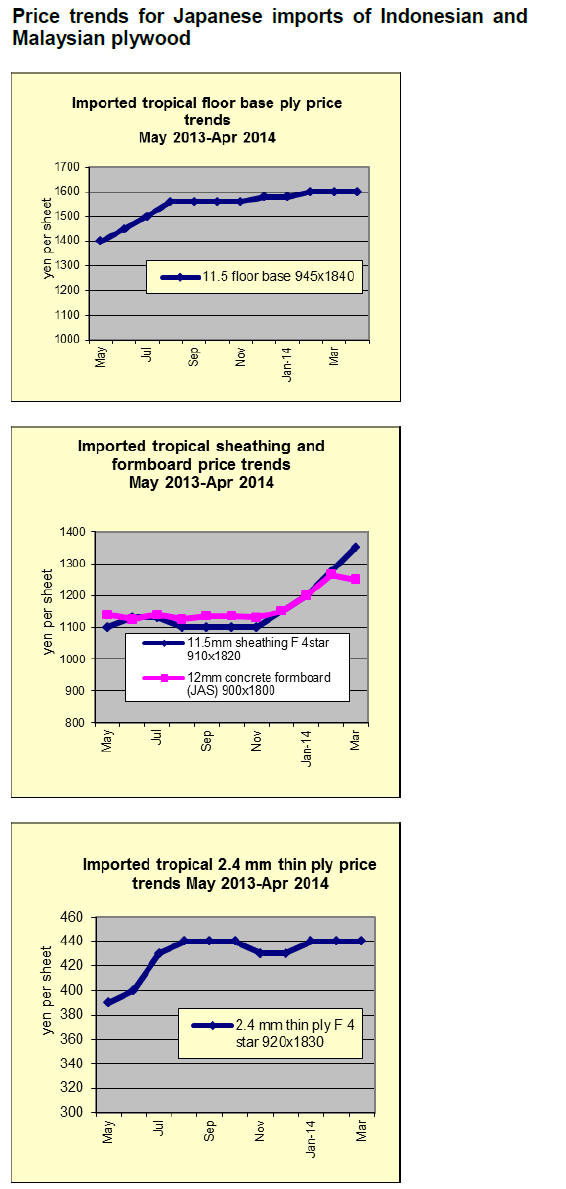
Sattsuru Plywood changes log storage
Sattsuru Plywood in Hokkaido has been consuming South
Sea hardwood logs from Malaysia and PNG for plywood
manufacturing. The main species are yellow and red
meranti. It has six or seven shipments a year. One
shipment is about 5,000 cbms.
Logs are unloaded and stored at water log storage of port
of Kushiro but the port decided to close its water log
storage because of safety since logs got out of the storage
and moved up Kushiro river in downtown Kushiro then
deterioration and difficulty of financing for maintenance.
Sattsuru has to relocate log unloading port and storage and
decided to change to port of Tokachi. Sattsuru considered
option of dry land log storage but it requires fumigation,
water sprinkling during summer months and anti-freeze
spray during winter, which is too costly so even though
distance from Tokachi port to plywood mills is much
longer than Kushiro, it decided to use Tokachi port.
Trends in office, kitchen and bedroom furniture
imports
Japan‟s office kitchen and bedroom furniture imports from
2009 to the end of February 2014 are shown below. March
figures will not be available until the end of April.
Japanese imports of furniture exhibit a cyclical trend
between 2009 and 2012. However, from 2012 bedroom
furniture imports began to increase and have continued
upwards since.
February furniture imports fell sharply as Japanese
importers adjusted stock levels in anticipation of declining
demand as housing starts stall and as the demand for
replacement furniture subsides because of the
consumption tax increase.
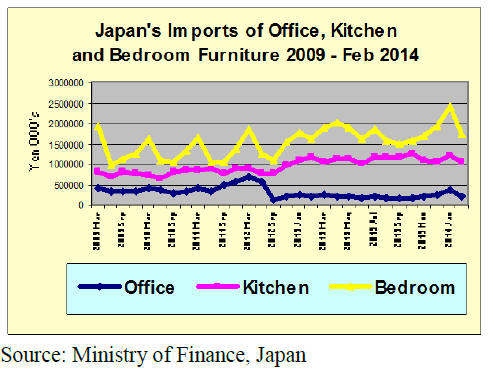
|